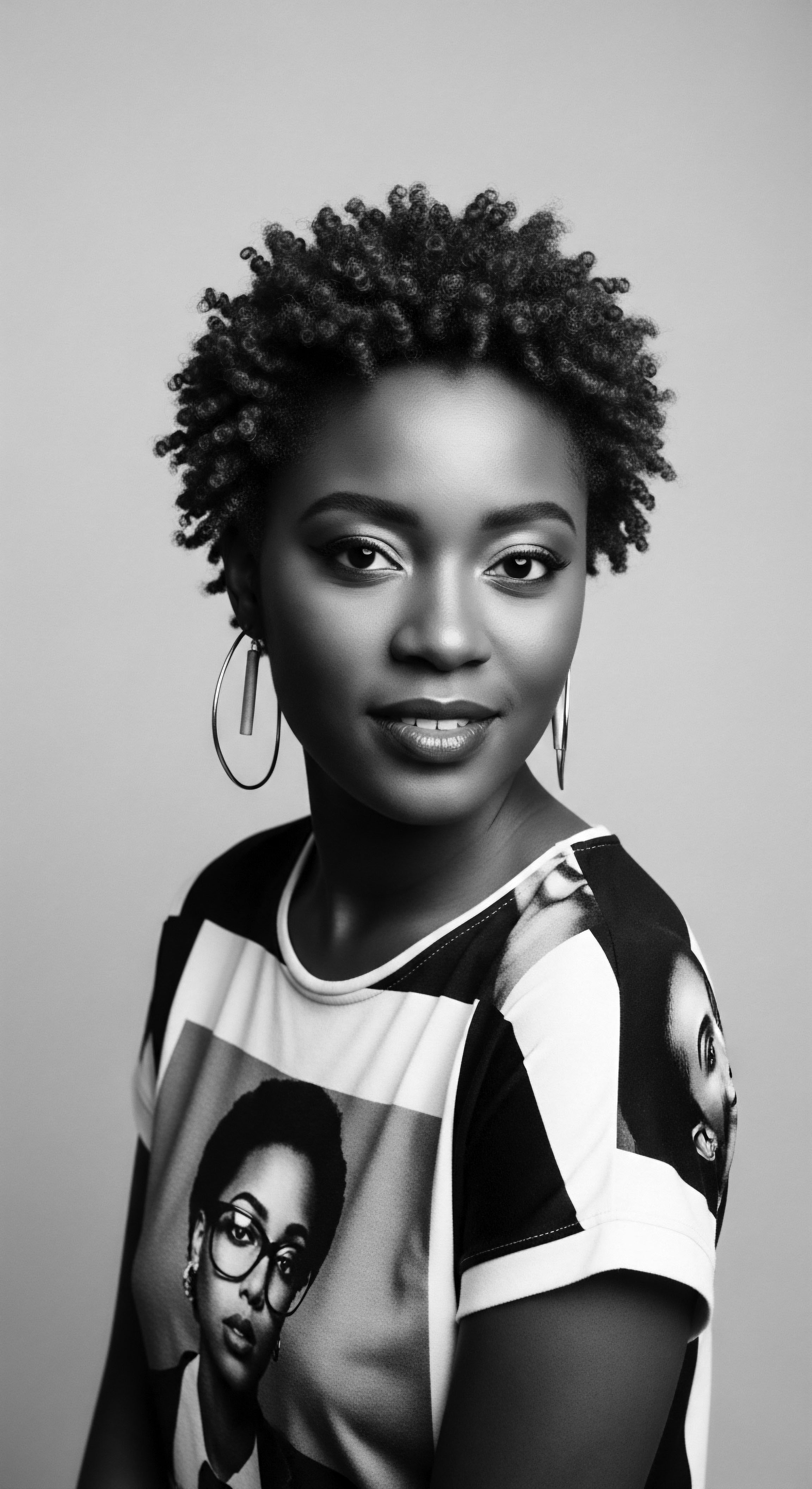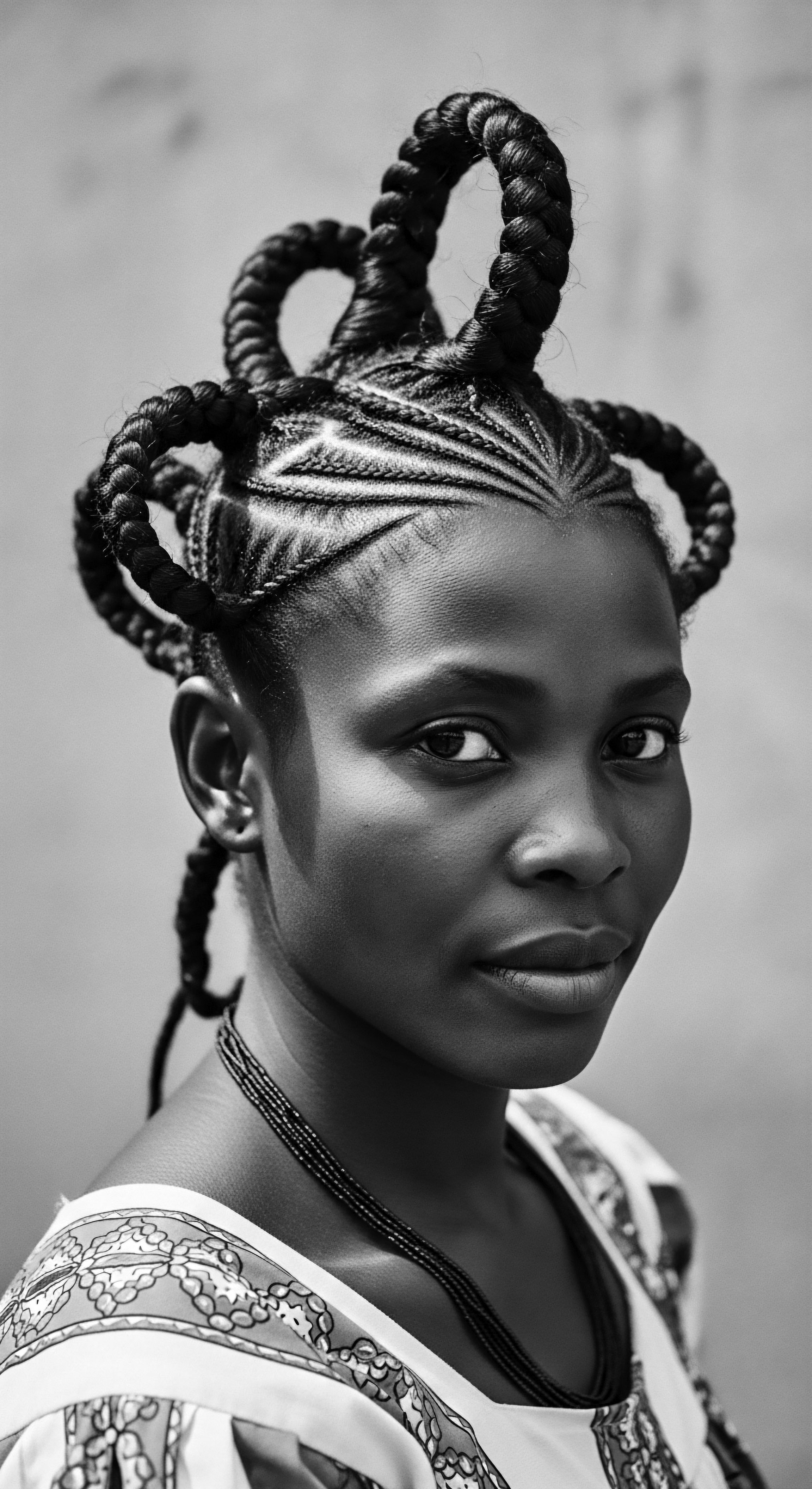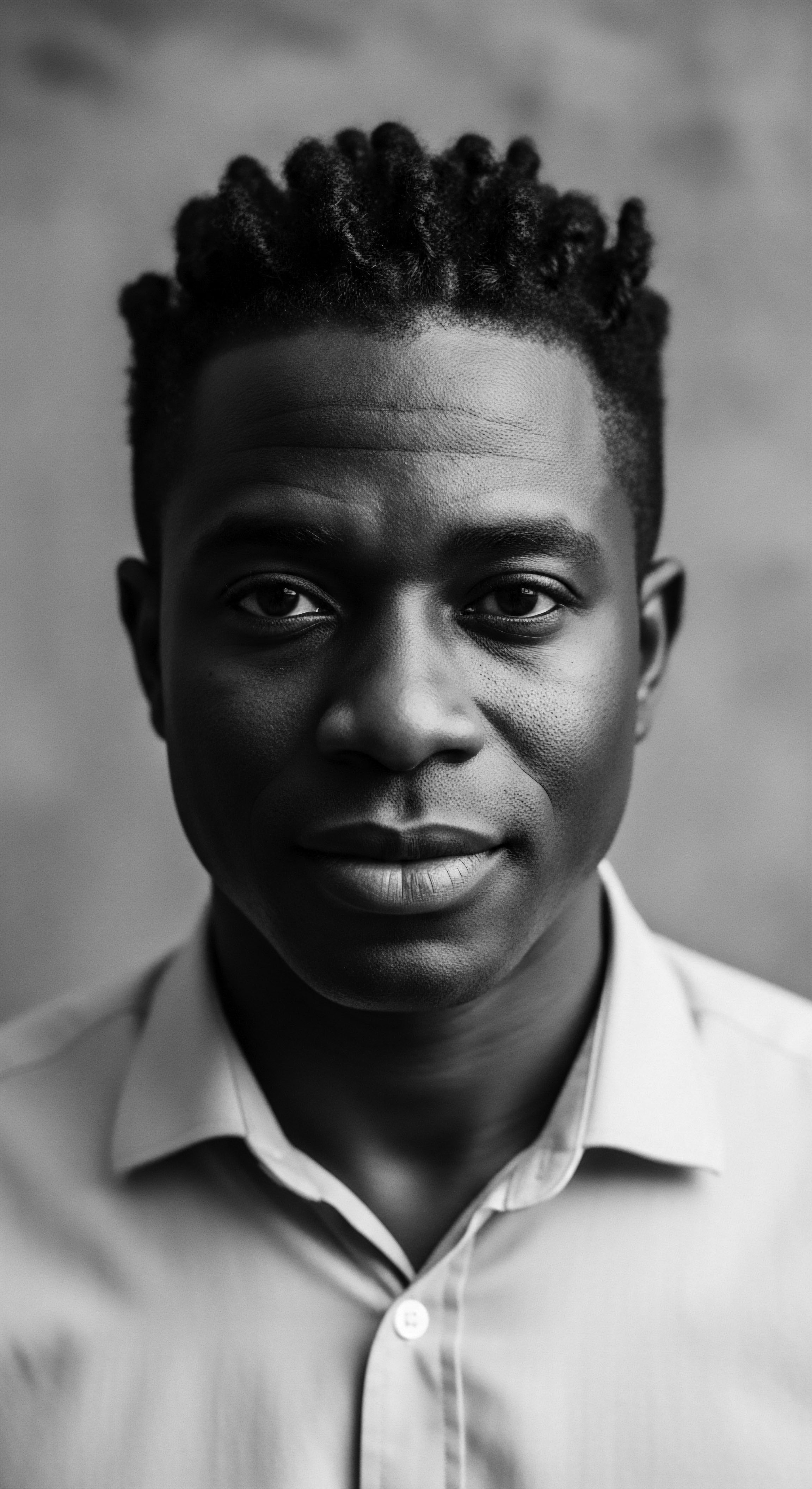
Roots
To journey with textured hair is to walk a path deeply etched with ancestral memory. Our strands carry echoes from the source, living archives of ingenuity, resistance, and self-possession. The combs we use, then, are never mere tools; they are extensions of a heritage, imbued with the meaning of their origins, the hands that shaped them, and the hair they have touched across millennia.
What stories do different comb materials tell for textured hair? They speak of survival, artistry, and an unbroken connection to identity.
The earliest whispers of combs for textured hair begin in the very cradle of civilization, across ancient Africa. Here, hair was more than adornment; it was a profound communicator of lineage, status, spirituality, and tribal affiliation. Combs from these eras, dating back over 5,500 years, were often carved from the materials abundant in their natural environments. Archaeological finds from Kush and Kemet, now Sudan and Egypt, reveal combs of Wood, Bone, and Ivory buried with their owners, testament to their sacred significance in life and beyond.
These were not simple grooming aids. They were crafted expressions of culture, reflecting an intimate understanding of textured strands long before modern classifications existed.

Ancient Materials and Their Deep Resonance
Consider the ancient wooden comb. Crafted from various hardwoods like olive, rubber wood, or mahogany, these combs possessed a natural warmth and durability. Their smooth, often wide-set teeth moved with a gentle deference through coiled or kinky hair, minimizing breakage while distributing the hair’s natural oils. Beyond their practical function, these wooden combs became canvases for spiritual and social expression.
In many African traditions, the comb served as a tangible link to spiritual realms, its use a ritualistic act of care. Designs etched into the wood might symbolize protection, fertility, or group identity. For instance, among the Akan of Ghana, the Duafe, a wooden comb symbol, stands for femininity, patience, prudence, and care, often given as a declaration of love or a marriage gift. The very act of crafting these combs from wood connected the user to the earth, to the trees that provided the material, grounding the grooming ritual in the natural world.
From ancient African civilizations, combs of wood, bone, and ivory were not just tools; they were sacred extensions of identity and spirit for textured hair.
Bone and Ivory combs also hold a significant place in this history, particularly in ancient Egypt. These materials, requiring intricate carving skills, marked status and refinement. Mummified remains from ancient Egypt display a variety of hair types, including coiled and braided styles, cared for with such tools.
The presence of these combs in burial offerings underscores their enduring importance, suggesting they were considered essential companions for the afterlife. The delicate craftsmanship of an ivory comb, perhaps adorned with depictions of deities or animals, spoke volumes about the wearer’s societal standing and connection to cultural beliefs.
| Material Source Wood (e.g. olive, mahogany, rubber wood) |
| Historical Application for Textured Hair Gentle detangling, oil distribution, base for traditional styling. |
| Cultural or Symbolic Significance Connection to earth, ancestral wisdom, feminine virtues (Akan Duafe). |
| Material Source Bone (e.g. animal bone) |
| Historical Application for Textured Hair Durable grooming, often with wider teeth for coily hair. |
| Cultural or Symbolic Significance Practicality, survival, ingenuity in resourcefulness (especially during forced migration). |
| Material Source Ivory (from tusks) |
| Historical Application for Textured Hair Fine grooming, decorative pieces for elite. |
| Cultural or Symbolic Significance Status, luxury, artistic expression, spiritual connection (Ancient Egypt). |
| Material Source Horn (animal horn) |
| Historical Application for Textured Hair Smooth glide, antistatic properties for delicate strands. |
| Cultural or Symbolic Significance Natural materials, craftsmanship, community bonding through shared care. |
| Material Source These foundational materials shaped not only hair but also the enduring heritage of textured hair care practices. |

Ritual
The essence of textured hair care extends beyond mere functionality; it resides in ritual, in the deliberate acts of tending to our strands that bridge past and present. Different comb materials have always played a part in these practices, adapting through time while carrying forward the weight of tradition and the resilience of a people. How have these materials shaped the very art and science of textured hair styling through generations? Their journey parallels the lived experiences of Black and mixed-race communities, reflecting both innovation and the steadfast adherence to ancestral care.

Tools of Transmission ❉ Comb Materials in Styling Heritage
As communities adapted, so did their tools. The ingenuity of African peoples, particularly in the diaspora, ensured that hair care practices, even under duress, found new expressions. During the transatlantic slave trade, when access to traditional tools was severed, enslaved Africans sometimes fashioned combs from available materials like wood scraps, metal pieces, and animal bones.
This resourcefulness speaks to the profound determination to maintain personal care and a connection to self, despite systematic attempts at dehumanization. Hair, and its grooming, became an act of quiet defiance, a way to hold onto humanity and identity.
The materials of combs shifted with technological progress and societal changes, yet the core principles of textured hair styling persisted. While ancient materials served as initial foundations, the late 19th and early 20th centuries saw the advent of Metal Combs. The hot comb, a metal tool heated over fire or a stove, emerged as a means to achieve straighter styles, a response to prevailing Eurocentric beauty standards.
This period highlights a complex chapter in textured hair heritage, where tools reflected both adaptation and the pressures to conform. Women, particularly in rural areas, sometimes improvised with everyday items like eating forks, heating them for a similar effect, underscoring the lengths to which individuals went to shape their hair.
Comb materials reflect a heritage of resilience, from ancient crafts to diasporic ingenuity in maintaining textured hair traditions.
By the mid-20th century, the rise of Plastic revolutionized comb production, making tools more accessible and affordable. This marked a significant shift from handcrafted implements. While some might see plastic as a material devoid of historical resonance, its ubiquity allowed for the mass production of the Afro Pick, an iconic tool that would soon symbolize racial pride and political consciousness. The afro pick, with its long, wide teeth, was specifically designed to lift, shape, and maintain voluminous afro styles, celebrating the natural texture of Black hair.

The Symbolic Shift ❉ From Utility to Statement
The afro pick, often made of plastic with a metal handle, carried a message. Often adorned with the powerful clenched fist symbol of Black Power, it transformed from a mere styling device into a bold declaration of identity, resistance, and self-acceptance during the Civil Rights Movement of the 1960s and 1970s. This period witnessed a powerful reclamation of natural hair, and the afro comb became a visible emblem of that movement. The material, whether simple plastic or a more decorative metal, mattered less than the powerful message it conveyed when worn proudly in an afro.
Consider the shift in how combs were perceived across different moments in Black hair heritage:
- Ancient Ancestry ❉ Combs carved from local resources like Wood and Bone served as practical grooming tools, but also held profound ceremonial and communicative weight, signifying status, tribal affiliation, and spiritual connection.
- Diaspora Ingenuity ❉ During chattel slavery, scarcity of traditional tools led to improvisation, with individuals repurposing everyday objects or raw materials to care for their hair, a testament to enduring cultural practices.
- Post-Emancipation Adaptation ❉ The advent of Metal Hot Combs responded to societal pressures for straightened hair, yet their use also allowed for easier hair management and played a role in economic empowerment for Black women.
- Civil Rights Era Reclamation ❉ The widespread adoption of Plastic and Metal Afro Picks during the Black Power Movement represented a conscious rejection of Eurocentric beauty norms, becoming a powerful visual symbol of cultural pride and political solidarity.

Relay
The historical meaning of comb materials for textured hair is a narrative of ancestral wisdom, resilience, and identity passed across generations. This story is not static; it lives in the shared acts of care, the whispered techniques from elder to youth, and the very materials we choose to connect with our hair. How does this deep understanding of comb materials inform a holistic approach to textured hair care rooted in heritage? It urges us to consider the echoes of our past in every stroke.

Cultural Custodianship of Care Tools
The choice of comb material has always been intertwined with the understanding of textured hair itself. Ancient African societies intuitively understood the unique needs of kinky, coily, and curly hair types, crafting tools with wide teeth and rounded tips to navigate the intricate patterns without causing undue breakage. This knowledge, often embedded in communal grooming rituals, was a form of generational teaching. The texture of the comb, its weight, and its feel in the hand all contributed to a mindful, holistic care experience.
Understanding the heritage of comb materials provides a pathway to holistic care, connecting us to ancestral practices of nurturing textured hair.
Even today, the wisdom of choosing materials that respect our hair’s delicate structure holds sway. Consider the enduring appeal of Wooden Combs for textured hair. Modern science validates what ancestors instinctively knew ❉ wood is naturally antistatic and its smooth pores minimize friction, allowing for a gentle glide through curls and coils.
This contrasts sharply with some contemporary plastics that can generate static, leading to increased frizz and potential breakage. The shift towards sustainable materials in modern wellness spaces often finds its roots in these ancient, material-conscious practices.

A Legacy of Adaptation and Innovation
The journey of comb materials for textured hair reflects a continuous dialogue between tradition and adaptation. While colonial influences often attempted to suppress Indigenous hair practices and demonize textured hair, the knowledge of care persisted, often through clandestine means. Communities in the diaspora found ways to create or adapt tools, ensuring the continuation of hair rituals that were central to their identity. This historical adaptation underscores the profound connection between the materials of our tools and the resilience of our cultural practices.
One poignant example of this resilience lies in the period of slavery in the Americas. Africans, forcibly removed from their lands and cultures, often had their heads shaved as a calculated act to strip them of identity and lineage. Deprived of their traditional combs and hair preparations, they improvised. Mamie Barnes and Marie Davenport, women from rural Mississippi, recalled how their grandmothers used Eating Forks Heated on a Stove as makeshift combs, a testament to the desperate ingenuity in maintaining some semblance of hair care and self-dignity under brutal conditions.
This specific historical instance speaks volumes about the intrinsic value placed on textured hair care, compelling individuals to adapt everyday objects into tools for grooming, however harsh. This act of adaptation, making do with available materials, became a critical component of survival and cultural preservation.
The evolution of combs also reflects broader societal changes and the ongoing conversation surrounding textured hair. While synthetic materials became prevalent for their accessibility, there is a renewed appreciation for historically significant materials. The design of combs specifically for textured hair—those with wider gaps between teeth and robust construction—stems from millennia of understanding hair physics long before formal scientific inquiry.
- Wooden Combs ❉ Valued for natural feel, static reduction, and connection to ancestral earth practices. They remain a preferred choice for gentle detangling and oil distribution.
- Horn and Bone Combs ❉ Revered for their smooth surfaces and durability, reflecting early human ingenuity in toolmaking and animal resource utilization.
- Metal Combs ❉ Introduced for straightening, marking a complex period of adaptation to external beauty standards, yet also signifying innovation in styling options.
- Plastic Afro Picks ❉ While modern, their iconic status during the Black Power Movement transformed them into symbols of cultural pride and political expression for natural hair.
The dialogue between heritage and contemporary care continues to shape our choices. From the carefully carved wooden tools of ancient Africa to the mass-produced afro picks that became symbols of a movement, each material carries layers of cultural and historical meaning for textured hair. This understanding not only respects the journey of our ancestors but also empowers us to make informed choices that honor our strands, recognizing them as living connections to a powerful legacy.

Reflection
Our journey through the historical meaning of different comb materials for textured hair reveals more than a chronicle of tools. It unveils a profound truth ❉ hair, in its glorious coils and kinks, has always been a living, breathing archive of Black and mixed-race experience. Each material, from the ancient warmth of carved wood to the defiant stance of the modern afro pick, carries the whispers of generations who understood hair not as a mere aesthetic feature, but as a sacred extension of self, community, and enduring spirit.
The materials of our combs, then, are not simply functional; they are imbued with ancestral wisdom, political statements, and the quiet dignity of a heritage that persists and thrives against all currents. They remind us that the ‘Soul of a Strand’ is, indeed, timeless, a continuous story written in every curl, every coil, and every intentional act of care.

References
- Akanmori, Harriet. (2015). Hairstyles, Traditional African. In T. L. Bankhead (Ed.), The SAGE Encyclopedia of African Cultural Heritage in North America (pp. 441-443). SAGE Publications, Inc.
- Byrd, Ayana D. & Tharps, Lori L. (2001). Hair Story ❉ Untangling the Roots of Black Hair in America. St. Martin’s Press.
- Dabiri, Emma. (2019). Don’t Touch My Hair. HarperCollins.
- Gordon, Lewis R. (2008). An Introduction to Africana Philosophy. Cambridge University Press.
- Mercer, Kobena. (1994). Welcome to the Jungle ❉ New Positions in Black Cultural Studies. Routledge.
- Sieber, Roy, & Herreman, Frank. (2000). Hair in African Art and Culture. Museum for African Art.
- Stokrocki, Mary. (2010). An intergenerational and semiotic exploration of hair combs as material culture. International Journal of Education through Art, 6(2), 161-177.
- Tarlo, Emma. (2016). Entanglement ❉ The Secret Lives of Hair. Oneworld Publications.
- Tate, Shirley Anne. (2007). Black Beauty ❉ African American Women and the Politics of Race, Gender, and Appearance. Routledge.
- Thompson, Cheryl. (2009). Black Women and Identity ❉ The Politics of Hair. Gender & Society, 23(1), 74-95.
